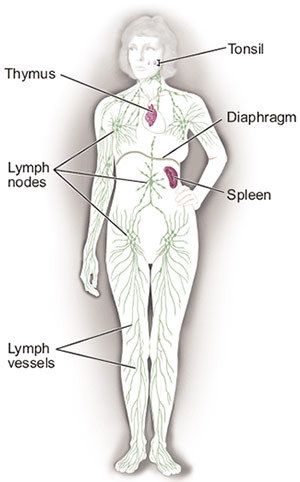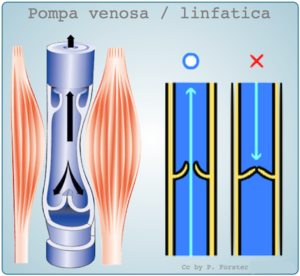Lymphatic System
Introduction[edit | edit source]
Lymph is the fluid that flows through the lymphatic system and surrounds all tissues.
- Lymph flows through lymphatic vessels and lymph nodes and is part of the immune system that is responsible for removing foreign microbes to lymph nodes and returning proteins to the blood.
- Unlike blood, which flows around the body in a loop by force created by the pumping mechanism of the heart, lymph flows in only one direction, upwards towards the neck.
- The direction of the flow of lymph is controlled by valves and the flow is controlled by force created by activation surrounding muscles and the fact that the pressure is different than in blood vessels [1].
- Problems that lymph may cause are primarily because there is no pump like blood have [2].
- Lymph Lymph contains lymphocytes and macrophages which are important cells: 1. Lymphocytes contain T Cells, B Cells, and killer cells that increase in number to fight disease and any foreign object detected by the body. 2. Microphages that absorb, or better say eat foreign microbe.
Lymphatic System[edit | edit source]
The anatomy of the lymphatic system closely parallels that of the peripheral vascular system. It functions by unilaterally returning lymphatic fluid to the vascular system where it is eliminated.
Almost every organ in the body has lymphatics which generate a variety of byproducts that require elimination. Examples of organs in the body that contain lymphatic tissue include the gastrointestinal (GI) tract, spleen, lymph nodes, tonsils, and thymus.
- Lymph nodes function to monitor the composition of lymphatic fluid/blood, engulf any pathogens, augment an immune response, and eradicate infection.
- The thymus serves to mature and develop T cells in response to an inflammatory process, immune response or malignancy.
- The absorption and transport of fats and fat-soluble vitamins from the GI system also requires lymphatics.
- The lymphatic fluid is eventually emptied at the junction of the left subclavian vein and left internal jugular veins.
- Lymphatic fluid is derived from plasma. It leaks out of the capillary walls because of pressure exerted by the heart or osmotic pressure at the cellular level.
- In the GI tract, the lymphatic fluid has a milk-like appearance that is chiefly due to the presence of cholesterol, glycerol, fatty acids and other fat products. The vessels that transport the lymphatic fluid from the GI tract are known as lacteals.
- Lymphatic capillaries are very thin vessels which are blind-ended tubes. The lymphatic capillaries tend to form a large network of tubes that are known as lymphatic vessels.
- The key feature of lymphatic vessels is that they have thin endothelial walls and have an overlapping arrangement. This morphology allows for any fluid from the tissues to enter the cells. [3]
Diseases of the Lymphatic System[edit | edit source]
The lymphatic system is also prone to diseases like the venous and arterial circulation. Eg
- Lymphedema. When this occurs, the lymphatic system is unable to drain lymphatic fluid which results in accumulation of the fluid causing swelling of the extremity. Lymphedema is classified as primary or secondary.
- Primary lymphedema is an inherited disorder where the lymphatics may be missing or poorly developed. This condition usually presents soon after birth or sometimes may present later in life. There are no great treatments for primary lymphedema. Surgery procedures of the past era were found to be mutilating and not done today. The present-day treatment revolved around the use of compression stockings, pumps, and constrictive garments.
- Secondary lymphedema is an acquired disorder that has many causes including cancer, infection, trauma or following a surgical procedure. The treatment depends on the cause. In most cases, if the inciting cause is removed, the drainage will resume. However, one may need to wear compressive stockings permanently in some cases. Physical therapy may help when the extremities are involved.
- Lymphomas are malignancies that arise from the cells of the lymphatic system. There is usually malignant transformation of specific lymphocytes in the lymphatics or lymph nodes that are present in the gastrointestinal tract, neck, axilla or groin. Symptoms of lymphoma may include night sweats, fever, fatigue, itching and weight loss.
- Cancers of a variety of organs may commonly spread to involve regional lymph nodes.
- Lymphadenitis occurs when the lymph nodes become inflamed. The cause is usually an adjacent bacterial infection. The lymph nodes usually enlarge and become tender.
- Filariasis is a very common disorder caused by a parasite in Africa. The parasite rapidly divided and obstructs the lymph nodes in the groin, making it difficult for the lymphatics to drain the extremity. This often results in huge extremities and marked disability.[3]
Physiotherapy[edit | edit source]
Physiotherapy has a crucial part in resolving problems with the lymph using the technique lymphatic drainage and exercise [4],[2], [5] [6]. Exercise induces transport of lymph. Movement of muscles and arterial pulses cause the transport of lymph through the lymphatic system. Being active therefore has a positive effect of lymphatic system and the movement of lymph through our body. Some activities that are recommended are swimming, brisk walking, tennis, jumping, gymnastic, deep breathing, etc [7] [8]
Manual lymph drainage has shown to be of benefit in examples below
- Hind foot operations:the application of lymph drainage techniques after hindfoot (the posterior part of the human foot that contains the calcaneus, talus, navicular, and cuboid bones) operations, in combination with standard physiotherapy exercises, achieves greater limb volume reduction than exercise alone. [9]
- Breast cancer related lymph edema:[10] [11]
- Sports Medicine and Rehabilitation.[12]
References:[edit | edit source]
- ↑ The Editors of Encyclopaedia Britannica. Lymph. Available from:https://www.britannica.com/science/lymph, (accessed 15/02/2019)
- ↑ 2.0 2.1 L.Felts. Detox your lymph: 10 holistic treatments for your lymphatic system. Available from: https://thechalkboardmag.com/detox-your-lymph-10-holistic-treatments-for-lymphatic-system (accessed 13/02/2019)
- ↑ 3.0 3.1 Null M, Agarwal M. Anatomy, Lymphatic System. InStatPearls [Internet] 2019 Jun 22. StatPearls Publishing. Available from:https://www.ncbi.nlm.nih.gov/books/NBK513247/ (last accessed15.2.2020)
- ↑ A. Weil. Lymphatic Massage Therapy. Available from: https://www.drweil.com/health-wellness/balanced-living/wellness-therapies/lymphatic-massage-therapy/ (accessed 12/02/2019)
- ↑ Boon C.C. Manual lymph drainage. Available from: https://www.physio-pedia.com/manual_lymph_drainage (accessed 11/02/2019)
- ↑ Dіdem K, Ufuk YS, Serdar S, Zümre A. The comparison of two different physiotherapy methods in treatment of lymphedema after breast surgery. Breast cancer research and treatment. 2005 Sep 1;93(1):49-54.
- ↑ L. Vandermeeren, G. Van Damme, S. Stein, N. Devoogdt, B. Clerinks, P. Vlecken, L. Martens, K. Tollenaere, N. Beauloye. Report Patient Day 29 october 2017. Available from: https://www.belymph.org/web/en/belymph/patient-day (accessed 16/02/2019)
- ↑ S. Ding. 16 warning sings that you need to drain your lymphatic fluids. Available from: https://juicing-for-health.com/how-to-drain-your-lymphatic-fluids (accessed 12/02/2019)
- ↑ Kessler T, de Bruin E, Brunner F, Vienne P, Kissling R. Effect of manual lymph drainage after hindfoot operations. Physiotherapy Research International. 2003 Jun;8(2):101-10.
- ↑ Atalay OT, Özkir A, Çalik BB, Baskan E, Taşkin H. Effects of phase I complex decongestive physiotherapy on physical functions and depression levels in breast cancer related lymph edema. Journal of physical therapy science. 2015;27(3):865-70.
- ↑ Lacomba MT, Sánchez MJ, Goñi ÁZ, Merino DP, del Moral OM, Téllez EC, Mogollón EM. Effectiveness of early physiotherapy to prevent lymphoedema after surgery for breast cancer: randomised, single blinded, clinical trial. Bmj. 2010 Jan 13;340:b5396.
- ↑ Vairo GL, Miller SJ, Rier NC, Uckley WI. Systematic review of efficacy for manual lymphatic drainage techniques in sports medicine and rehabilitation: an evidence-based practice approach. Journal of Manual & Manipulative Therapy. 2009 Jul 1;17(3):80E-9E.








